Sudoku
April 1st Sudoku
Apr 1st
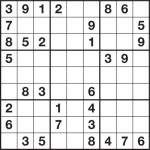
Sudoku April 1st puzzleWow, it is a long time since I posted here. So much to do, so little time!
I guess that means I might as well keep it brief now, then. On that basis:
Here’s a puzzle for April 1st. It’s actually a normal puzzle without tricks – it just spells ‘FOOL’ in the given numbers. Like any Sudoku, simply place 1 to 9 in each row, column and bold-lined box.
Valentine Sudoku
Feb 14th
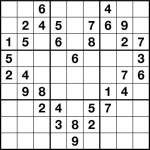
Valentine SudokuA quick heart-shaped sudoku for Valentine’s Day. Just place 1 to 9 once each in every row, column and bold-lined box.
Christmas Star Sudoku
Dec 21st
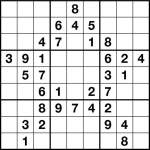
Sudoku Christmas Star puzzleA Sudoku, in a star shape.
Just that. (Place 1-9 once each into every row, column and bold-lined 3×3 box).
101 Giant Sudoku series
Jul 29th
I’ve recently launched a new series of ‘101 Giant Sudoku’ books, to cater for those who like their Sudoku to be considerably larger than normal!
You can see the entire series at PuzzleBooks.org (scroll to the bottom) or visit Amazon and search for “101 giant sudoku”.
There are currently 12 books in the series: 14×14, 15×15, 16×16, 18×18, 20×20, 21×21, 22×22, 24×24, 25×25, 28×28, 30×30 and 36×36.
The larger puzzles work just as you’d expected, so in Sudoku 36×36, for example, you must place 0-9 and A-Z into every one of the 36 rows, 36 columns and 36 6×6 boxes!
These puzzles are designed so they don’t need any advanced logic – just scan the rows and columns and boxes to see what’s missing and what can fit where.
All of the puzzles are designed with attractive 8-way symmetry patterns.
Little Killer Sudoku
Jun 21st
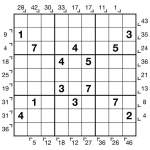
Little-Killer Sudoku 9×9 1 puzzleIn Little-Killer Sudoku the total of each of the diagonals in the grid, other than those 9 cells long, is given. Each number has an arrow next to it which points to the diagonal it gives the sum of, so therefore the top-left cell in this grid must be a 9 thanks to the arrow immediately below and to the left of it. Unlike in regular Killer Sudoku, there is no restriction on repeating digits in any sum.
I’ve also seen Little Killer puzzles which have an additional restriction that no number can repeat on either of the two main diagonals, but I haven’t used that rule here, so numbers can repeat. Apart from the addition of the Little Killer clues, this is a regular Sudoku puzzle.
Killer Sudoku Zero
Jun 20th
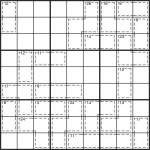
Zero Killer Sudoku 9×9 1 puzzleProbably because it sounded cool, or it was invented by someone who didn’t quite speak English, Killer Sudoku puzzles with some of the redundant clues removed are often referred to as ‘Zero’ Killer Sudoku. Or perhaps it’s because there are “zero redundant clues”. In any case, here’s one of those puzzles, where I have taken out all but the clues you definitely need to get a unique solution.
Usual Killer Sudoku rules apply: Place 1 to 9 in each row, column and bold-lined box as usual, but you must also ensure that each dashed-line cage adds up to the total given at the top-left of it. Numbers can not repeat in a dashed-line cage.
Speaking for myself, I found this puzzle really challenging to solve, but I can promise you that there’s no need to guess or use trial and error in any way – every deduction can be made using standard killer solving techniques.
Good luck! ![]()
Trio Odd-Even Sudoku
Jun 14th
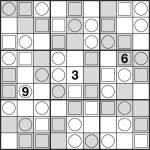
Sudoku Trio Odd/Even 9×9 1 puzzleI often post pretty challenging puzzles here, so I thought I’d entirely reverse that trend by publishing probably the easiest 9×9 puzzle with minimal givens you’ve ever seen.
Simply place 1-9 once each into every row, column and bold-lined region, as in a regular sudoku, but in this Odd/Even puzzle all of the even digits are in shaded cells. This is also a Trio sudoku too so each of the cells with an inset square contains 4, 5 or 6 and each of the cells with an inset circle contains 7, 8 or 9. Those without an inset square or circle contain 1, 2 or 3.
Using these rules you need only 3 givens for a valid unique puzzle. ![]() That’s the minimum number as you can probably easily convince yourself, because, despite its perhaps intimidating appearance, it’s essentially a set of trivial 1- and 2-digit sudokus laid on top of each other.
That’s the minimum number as you can probably easily convince yourself, because, despite its perhaps intimidating appearance, it’s essentially a set of trivial 1- and 2-digit sudokus laid on top of each other.
King of Argyle Sudoku
Jun 8th
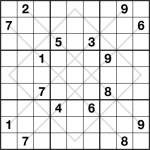
Sudoku Anti-King Argyle 9×9 1 puzzleSometimes it’s fun to mix variations together, so here’s a combination of Anti-king and Argyle Sudoku.
Anti-king means that no number repeats a “king’s move away in chess”. In practice this means that no two identical numbers touch in any direction, including diagonally.
Argyle means that no number repeats on any marked diagonal. The diagonals form an ‘Argyle’ Scots tartan pattern.
And since it’s a Sudoku, you must also place 1 to 9 in each row, column and bold-lined 3×3 box.
Good luck!
Frame Sudoku
Jun 7th
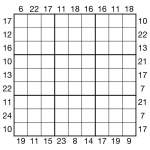
Frame Sudoku 9×9 1 puzzleHere’s a Frame Sudoku puzzle. Each number outside the grid gives the sum of the three nearest digits in that row or column, so for example if there is a 7 outside the grid then there must be a 1, 2 and 4 (1+2+4=7) in the first three cells in that row or column.
Regular Sudoku rules also apply – place 1 to 9 once each in all rows, columns and bold-lined boxes.
The actual logic in this is not especially tricky, but I certainly found it took me quite a while to test solve it (20 minutes or so, although I was watching TV…) – I’d be interested to know how long it takes you to solve it too!
Argyle Sudoku
Jun 1st
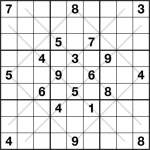
Sudoku Diagonal 9×9 1 puzzleI’m working on lots of different Sudoku variants for my forthcoming book, so I thought I’d post some of them here. On that basis, here’s an Argyle Sudoku puzzle. Just follow the usual rules but also note that you can’t repeat a digit in any of the marked diagonals.
You can now also keep track of this and future puzzles I publish using The Griddle’s puzzle tracking system. The following buttons update the status of the puzzle:
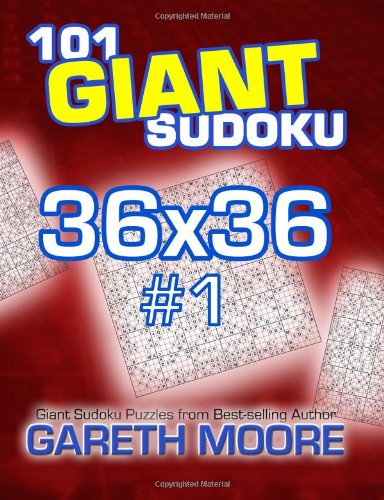

Recent Comments